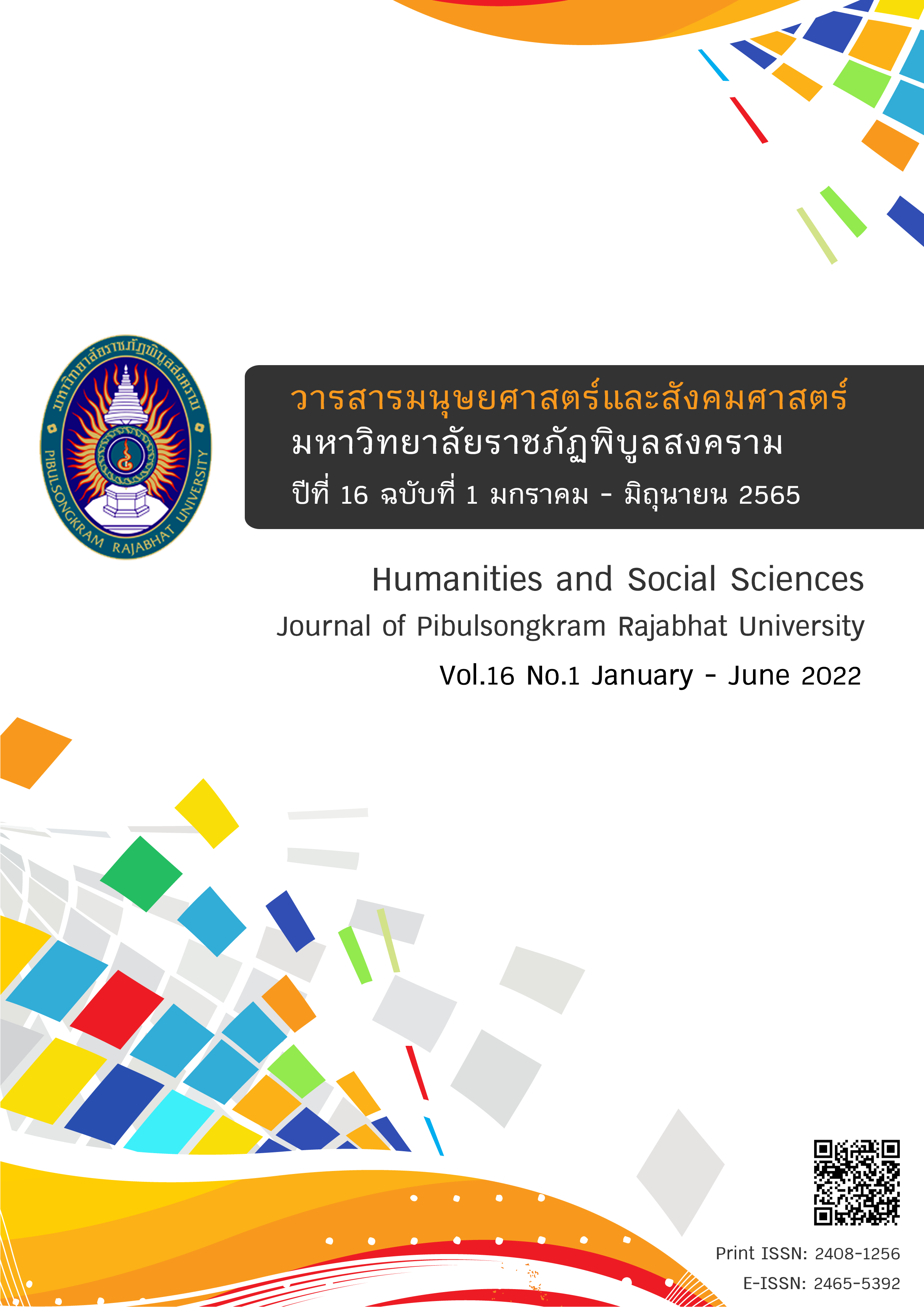องค์ประกอบความสำเร็จการจัดการเมืองสมุนไพรอย่างยั่งยืนของกลุ่มจังหวัด ภาคตะวันออกเฉียงเหนือตอนบน 2
DOI:
https://doi.org/10.14456/psruhss.2022.7คำสำคัญ:
องค์ประกอบ, ความสำเร็จ, เมืองสมุนไพร , ภาคตะวันออกเฉียงเหนือตอนบนบทคัดย่อ
งานวิจัยนี้มีวัตถุประสงค์เพื่อศึกษาองค์ประกอบและตัวชี้วัดความสำเร็จของการจัดการเมืองสมุนไพรสู่อย่างยั่งยืน เป็นการวิจัยแบบผสมผสาน (Qual ® quan) การค้นคว้าเอกสาร การสัมภาษณ์เชิงลึก และใช้แบบสอบถามตัวอย่าง จำนวน 270 คน และตรวจสอบองค์ประกอบเชิงยืนยันอันดับ 2 พบว่า 1) องค์ประกอบในการจัดการเมืองสมุนไพร พบว่า ข้อมูลที่เหมาะสมใช้ในการสร้างองค์ประกอบโดยใช้หลักทฤษฎีห่วงโซ่อุปทาน ได้แก่ ต้นน้ำ กลางน้ำ และปลายน้ำ และร่วมกับทฤษฎีการพัฒนาอย่างยั่งยืน ได้แก่ ด้านเศรษฐกิจ สังคม และสิ่งแวดล้อม 2) พัฒนาตัวชี้วัดการจัดการเมืองสมุนไพรอย่างยั่งยืน พบว่า มีปัจจัยที่เกี่ยวข้องจำนวน 9 ด้าน ๆ ละ 3 ตัวชี้วัด 3) การตรวจสอบองค์ประกอบความสำเร็จในการจัดการเมืองสมุนไพร พบว่า กลุ่มตัวอย่างส่วนใหญ่รู้จัก “เมืองสมุนไพร” ในระดับปานกลาง (ร้อยละ 45.19) และ รู้จักสมุนไพรน้อยที่สุด (ร้อยละ 1.48) รูปแบบองค์ประกอบมีความกลมกลืนกับข้อมูลเชิงประจักษ์ โดยมีค่าความกลมกลืนของโมเดลในภาพรวม เท่ากับ 0.911
เอกสารอ้างอิง
กรมพัฒนาการแพทย์แผนไทยและการแพทย์ทางเลือก. (2546). พระราชบัญญัติคุ้มครองและส่งเสริมภูมิปัญญาการแพทย์แผนไทย พ.ศ. 2542 (พิมพ์ครั้งที่ 2). กรุงเทพฯ: กระทรวงสาธารณสุข.
กระทรวงสาธารณสุข. (2560). แผนแม่บทแห่งชาติ ว่าด้วยการพัฒนาสมุนไพรไทย ฉบับที่ 1 พ.ศ. 2560 - 2564. นนทบุรี: ทีเอส อินเตอร์พริ้นท์.
ฐณัฐ วงค์สายเชื้อ. (2562). วิเคราะห์ถดถอยพหุด้วยโปรแกรม SPSS. สืบค้น 18 ธันวาคม 2562, จาก https://www.youtube.com/watch?v=XiBTuEQGrsY
ธีรยุทธ บุญโพธิ์. (2557). การสร้างความสัมพันธ์แบบเชื่อมโยง. สืบค้น 20 ธันวาคม 2562, จาก https://www.novabizz.com/NovaAce/Learning/Connectionism_Theory.htm
ประเวศ วะสี. (2546). สรุปผลการประชุมโต๊ะกลม เรื่อง การพัฒนาที่ยั่งยืน. กรุงเทพฯ: สำนักงานคณะกรรมการพัฒนาเศรษฐกิจและสังคมแห่งชาติ.
Barbier, E. B. (1987). The concept of sustainable economic development. Environmental conservation, 14(2), 101-110.
Barbier, E. B. (2013). Economics, natural-resource scarcity and development (Routledge revivals): Conventional and alternative views. Routledge.
Bennett, N. (1975). Popution growth, individual demongraphic decistions and the quality of life. A source book on population project. Bangkok: Mahidol University.
Open Development Thailand. (2562). เป้าหมายการพัฒนาอย่างยั่งยืน. สืบค้น 20 ธันวาคม 2560,
จาก https://thailand.opendevelopmentmekong.net/th/topics/sustainable-development-goals.
ดาวน์โหลด
เผยแพร่แล้ว
รูปแบบการอ้างอิง
ฉบับ
ประเภทบทความ
สัญญาอนุญาต
ลิขสิทธิ์ (c) 2020 วารสารมนุษยศาสตร์และสังคมศาสตร์ บัณฑิตวิทยาลัย มหาวิทยาลัยราชภัฏพิบูลสงคราม

อนุญาตภายใต้เงื่อนไข Creative Commons Attribution-NonCommercial-NoDerivatives 4.0 International License.
บทความหรือข้อคิดเห็นใดใดที่ปรากฏในวารสารมนุษยศาสตร์และสังคมศาสตร์ มหาวิทยาลัยราชภัฏพิบูลสงครามเป็นวรรณกรรมของผู้เขียน ซึ่งบรรณาธิการไม่จำเป็นต้องเห็นด้วย บทความที่ได้รับการตีพิมพ์เป็นลิขสิทธิ์ของวารสารมนุษยศาสตร์และสังคมศาสตร์ มหาวิทยาลัยราชภัฏพิบูลสงคราม









